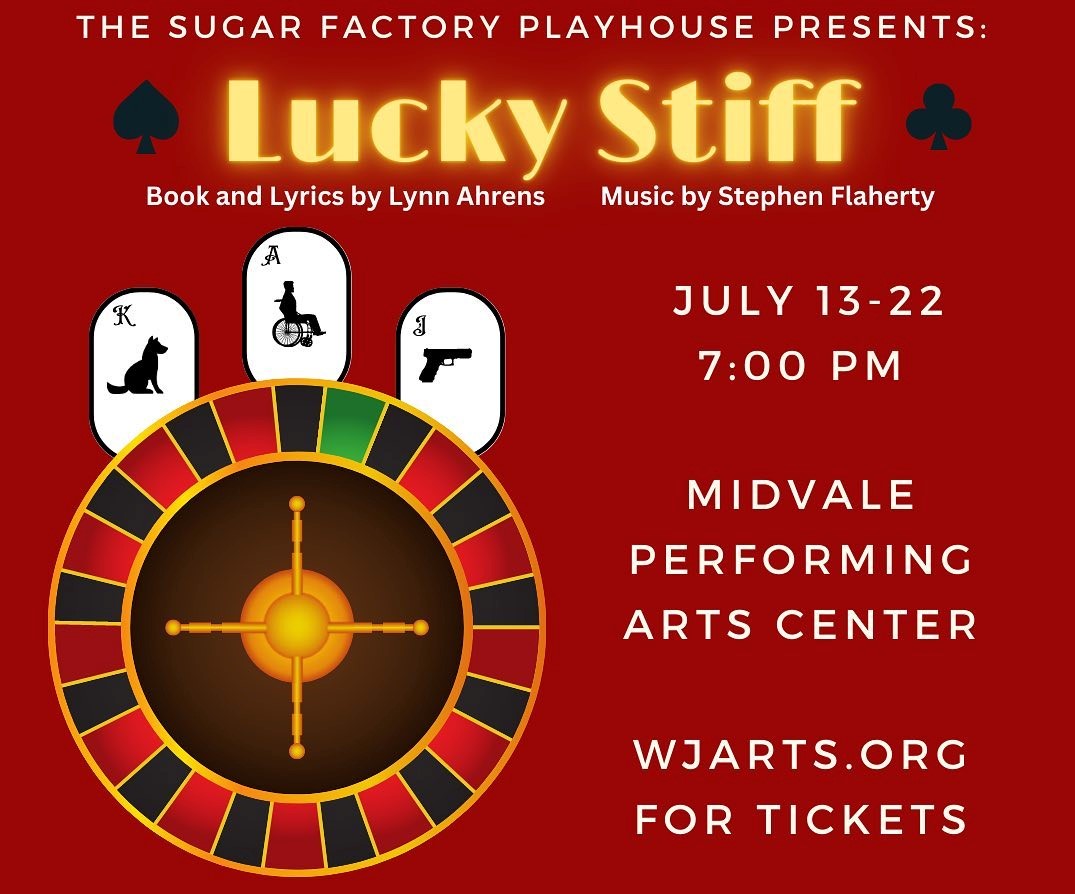MIDVALE — Lucky Stiff (book and lyrics by Lynn Ahrens, with music by Stephen Flaherty) produced by Sugar Factory Playhouse is playing at the Midvale Performing Arts Center; it’s a musical farce about Harry Witherspoon (played by Riley Kinsey), a shoe salesman in London, who finds out his uncle Anthony (the dead body played by Gary Rasmussen) has died and left him a large inheritance. Hijinks ensue when we learn that uncle Anthony intends to have Harry cart his corpse around Monte Carlo as his dying wish, but failure to do so means the Universal Dog Home of Brooklyn gets all the money instead. And since Harry hates dogs, it’s off to the French Riviera we go.

The stage is massive and unadorned with a smaller stage that wraps around (like a moat), and with each new scene, the props are brought out – and set up – by the actors. Less is more personifies the set design (done by Kassidy and David Rackham). With each new scene, new props (created by Denise Gull) are brought out or old ones are repurposed. When we meet Vinnie Di Ruzzio (played by Gary Kemp), the optometrist, there is a tall table that has a small display of eyeglasses with a large eye chart at the base. Then, in another scene, that same table is turned into a bar while we’re in Harry Witherspoon’s hotel room. In many ways, it was fun to rely on one’s imagination, but on a more practical note, it meant that we could be in more places at once, compared to a large, established set that only allows for one or two settings. Throughout Lucky Stiff, we traveled from London, to the eye doctor in Jersey, on both a train and a plane heading to Monte Carlo, a night out dancing and more.
Another stand out in the play are the accents which are sprinkled throughout; although Harry is British, he doesn’t have an accent, but his landlady very much does. While both Rita La Porta (played by Meg McCoy Reitz) and her brother Vinnie Di Ruzzio are from Atlantic City, NJ – only Rita has a distinct New York City accent, even though Annabel Glick (played by Kayley Singson) from the non-profit based out of Brooklyn has no accent. Perhaps this is directorial choice (done by Kassidy Rackham), and the accents are largely comedic in nature. Rita, the woman who essentially launches the play’s main event, is by far more interesting and dynamic than both Harry and Annabel, and both her accent (and glasses) add more flair to her character. Harry, who is meant to be humdrum (he is introduced wearing all brown) is probably too boring to have a British accent, which could fascinate the Americans he meets as he tries to keep a low profile.
Although the play is brightly lit for the first half, we start to see some unique lighting happen at “The Phone Call,” a solo number performed by Vinnie Di Ruzzio, where he calls his wife from a payphone to tell her that he’s in Monte Carlo and can’t make it to dinner. There is a single spotlight on him (and his sister) during this call and it marks the first of many creative uses of lighting. During “Speaking French,” a number performed by Dominique Du Monaco (played by Keri Griggs), she asks for a blue light, and gets it! Instead of a single blue spotlight, the entire stage is darkened with blue hues as she continues to sing. But the best, most dynamic use of lighting, is when Harry has a nightmare; in “Welcome Back Mr. Witherspoon” (an ensemble piece), the entire stage is dark, and the actors have glow sticks of various colors that they wave around. As the song progresses, the stage takes on different colored lights – green, blue and then red.
The play has a large cast, and no one character really stands out as the main character; even though we’re technically following Harry around, there’s also Annabel (who is following Harry), Uncle Anthony (who is dead) and recurring background and supporting characters (such as Luigi Gaudi – played by Don Smith). There are also characters with no names who play a variety of roles (some with or without lines). The lack of focus on any one character is exemplified by the music. For example, Harry only has two songs he sings alone, and both Rita and Annabel have their own numbers (“Fancy Meeting You Here” and “Times Like This,” respectively). It feels like a good way to balance out such a large cast, and helps paint a picture of what they want, their relationships to Harry (and other characters) and helps bring all the competing desires and ambitions together in the end.
The only truly confusing part of the play is that it’s meant to be a period piece (ie: payphones) but the costuming doesn’t reflect this. Or rather, the costuming (done by Denise Gull) feels unique, while not being tied to any specific time or place. The clearest example of this is Rita who wears a leopard print pair of heels throughout the play, and has large, leopard print rimmed glasses. But her outfit isn’t necessarily modern, it just correlates to her character. We also see this with Annabel, who dresses more modestly (knee length dresses and skirts) and we find out she’s not a fun or spontaneous person.
Lucky Stiff is a fun, evenly paced musical comedy that has fun twists as the play progresses. Definitely a must see for anyone who is a fan of Weekend at Bernie’s or enjoys ridiculous, and unlikely comedic scenarios.
[box]The Sugar Factory Playhouse’s production of Lucky Stiff plays at Midvale Performing Arts Center 695 West Center Street Midvale, UT on Monday-Saturday July 13-22, 2023. Tickets are $8-$12. For more information, visit https://www.wjarts.org/sugar-factory-playhouse.[/box]
